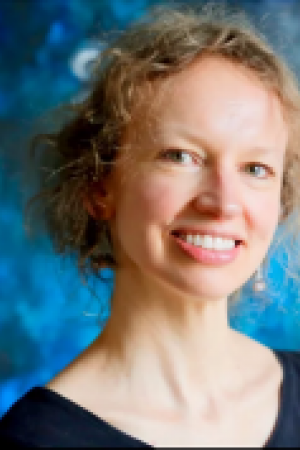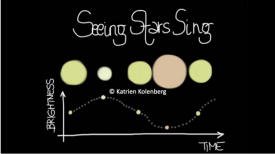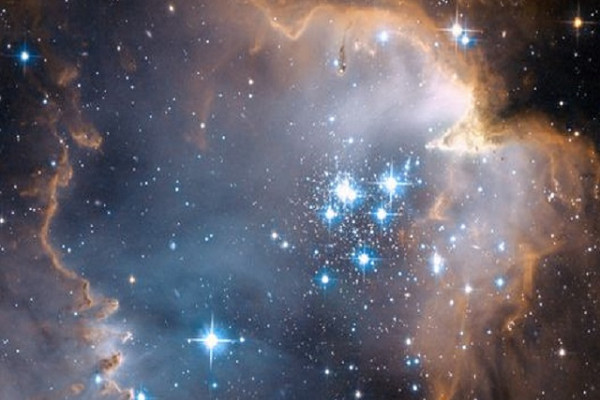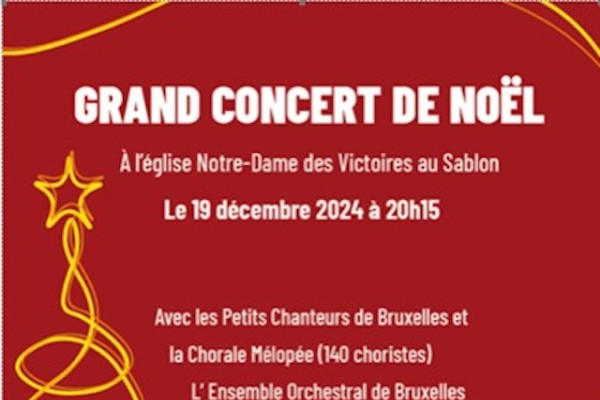
Our Universe is full of sound. From the tiniest to the largest noise, it is impregnated with and literally resonates meaning. We try to make sense of the cosmos that surrounds us in different ways. Using the scientific method, we build models that help us explain and predict multiple aspects of our existence. Through art, we search for meaning to this existence, give expression to it, and share it with others. Katrien Kolenberg will show us how astrophysics and the arts connect through an audio/visual presentation.
Katrien Kolenberg's work lies in the interstices of artistic expression and scientific exploration. After obtaining her PHD in astrophysics at the KU Leuven, she conducted research at the university of Vienna and at the Harvard-Smithsonian Center for astrophysics. Currently, she is professor of astrophysics at the University of Antwerp and the Free University of Brussels, STE(A)M* Coordinator at the KU Leuven, and an artist. She is passionate about using astronomy as a tool for global development and art to touch and reflect upon the human condition. *STE(A)M: Science Technology Engineering (Arts) Mathematics
Note: Content and images not intended for copyright infringement.

The monthly lecture of ISG was presented by Katrien Kolenberg, a Belgian astrophysicist, a professor of astrophysics at the University of Leuven and the Free University of Brussels.
On 13 September the audience was surprised to find on the podium a youngish delicate woman holding a cello in her hands. But everything became clear when she began her presentation. Our universe is impregnated with sounds, from the tiniest to the loudest which provide a precious tool for the astrophysicists for study. We try to make sense of the cosmos that surrounds us in different ways. Using the scientific methods, we build models that help us to predict multiple aspects of our existence. Through art we want to make sense of our existence and to reflect upon human conditions. Both things are indispensable tools for studying.
Katrien finds satisfaction connecting astrophysics and music. The reason is that the space is full of sounds. Though at first sight it does not look like that. She takes her cello and touches a string, it vibrates. We hear the sound. She explains: “We hear it because it lies within the human range of pitch, which is about 20 000 vibrations per second. But the celestial bodies though also emanate sounds, a human ear does not hear, because the sounds are too low for us. Now the scientists have learnt how to speed up the sounds of heavenly bodies so that we can hear them.”
Animals hear much lower sounds, insects much higher. We have our window for sounds. The celestial bodies, the planets which turn around a star also send off sounds, for example from the earthquakes. The space has a lot of sounds, which we can catch with the instruments. Our planet sends off sound waves from earthquakes. By the tremble of the cello Katrien demonstrated the sound of an earthquake, a sign that this is a planet. We can also hear the vibration of the planet Mars. Stars are different, they send off light. All the light of the Universe is coming from stars. They are very far away, so far away that we can’t get to them. Our nearby star is our sun, it is 150 000 000 km from the earth. Stars are Katrien’s favourite subject. The problem is that stars are so far that nobody can get to them. We see many stars around. They are giant clouds of ISG Newsletter October 2021 27 September 2021 www.isgbrussels.be Page 7 of 21 gas, which is why they are shining. It is a chemical reaction of the star. Stars live much longer, and many are much bigger than our sun. They also live and die like humans. But their life is on a different scale. There are instruments that measure their vibration which proves that they change as they age. Katrien touched the strings again to show us the vibrations of stars as opposed to the strings of the cello. The stars’ vibrations vary, from a fraction of a second to tens of scores. There are noisy stars. We can’t hear their vibration, because it is very low, but we can see that stars sing. They contract, get hotter and get brighter. Then they get dim, cool off. We see it through the telescopes and understand that they vibrate. Small dense stars make stellar sound. We speed it up and try to listen. We speed it up to 1 000 000-pitch so we can hear it.

If we look at the sunset, we see that our own sun vibrates. Its vibration lasts for five minutes. We speed it up and we hear it. This Rumbling is the basic sound of the sun. Katrien again touched the strings. “Let’s compare it with the cello. We hear modulations, they have small variations, and the sound of vibrations changes.” By the vibrations the scientists understand which material the stars are composed of. For example, gas. Light comes from outside of a star. We don’t know what is inside a star. But thanks to sounds we can divine the internal structure of stars. Our sun produces a rumbling sound. It is at the centre of the solar system. It appeared 4,6 billion years ago. The sun is changing. In the future it will transform into a red giant and then into a white dwarf. By the vibrations we understand that it is transforming into the red giant. The sun expands and probably will swallow nearby planets. It will be too hot for us to live nearby. Our history is short, just a few million years. Eventually the sun will be exhausted. It will turn into a very dense core and won’t be able to radiate the heat or the light. We know of cases when the far-off stars have turned into real diamonds. Very, very dense and super hot. These stars are bigger than planet Earth.
Regular stars we see through a telescope, we hear vibrations, which we can speed up. These stars are close together and they form part of the Milky Way. For us they serve as cosmic lighthouses. Stars consist of 70% hydrogen and 20% helium. The remaining 10% is metal and carbon. These are the same materials as found in our blood. That means that we are part of the composition of the stars.
Gravity is the major force that forces the Universe to revolve. We never see stars moving. We can’t see the movement with a naked eye. We have very precise instruments to see their projected moving. The Milky Way is our own island, which is not very far. Stars live long. When they die, they died already million years ago. Thus, we observe the past. Planets also interact. Jupiter has a loud haunting sound as if hit by lightning. Saturn has a spooky sound. We hear sounds of our own planet system. A ticking sound was detected by a female student several score of years ago which came from a pulsar. The sound of ticking is very precise. It ticks for millions of years. Pulsars are the stars at the end of their life. Black holes are walls of metal. Nothing escapes them, not even light. They absorb everything. There is a very big black hole in the centre of our galaxy. When two black holes merge, it is called Tango. This was an explosion in spacetime very long time ago with the energy is stored. It was detected from a sound of vibration, a special pitch like a clock. These are gigantic events.
We have to understand the stars. Looking at the stars we look into the past and into our future. But we can’t go physically beyond the moment of the Big Bang. When we observe the stars, we see what happened millions of years ago. The stars reveal their life and our own future. The building blocks for our bodies and of stars are the same – which is a fascinating idea. We are all part of the universe and of the galaxy. Our galaxy is one of many, many galaxies. Another fascinating idea is that gravity does not work. But we don’t’ know what works...
Conclusion
Yes, we know a lot about the Universe. Much more than people of previous centuries knew. We understand the creation of the stars, we hear their music, we feel their pulsation, we see their shimmer. But the more we learn, the more secrets the Universe puts in front of us. These are for future generations to solve. And the generations after them will get new enigmas. The universe is endless. Its secrets are also endless, and to learn or discover or solve all of them will never be possible. All our research starts with the Big Bang. But the Universe existed before the Big Bang and will go on existing. Researchers have opposing ideas of the time beyond the Big Bang.
Scientists want to find out whether other planets exist with suitable conditions for mankind’s survival. Probably, there are, but there are millions of planets. Or billions. Our lecturer spoke about the possibility of finding a planet suitable for our life. Something resembling our planet. I suppose we will eventually discover one. Suppose people will arrive there. And how do the creatures who live there will meet us? Will they take us as invaders? Will they ask us why we arrived and what we want to do there? “We need a place to live” – we’ll answer. “Will you make room for us?” What is next? A war? It would mean that people, conscientious creatures deliberately spread wars and destruction, and death. We understand that these questions present themselves many years after our lifetime. The chances for our civilization to survive seem rather questionable.
Astronomers are dreamers. They are lucky people. Our lecturer is doubly lucky, because she combines her profession – the astronomy with special attention to the stars with the music and the art.



